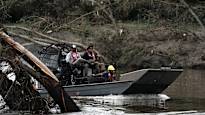The devastation caused by the weekend flash floods in Texas has left a somber cloud hanging over the state. With over 100 bodies already recovered, the search continues for a significant number of individuals still missing, five days after the tragic event unfolded. This ongoing operation in Texas marks one of the largest search and rescue missions in the state’s history.
The sudden and intense flash floods over the weekend claimed the lives of more than 100 people as the river’s water levels surged by over six meters in a matter of hours. The search for the missing continues in the treacherous terrain of the flood-affected areas, with rescue teams utilizing airboats, helicopters, and even horseback to comb through the vast expanse of devastation. Heavy machinery, human resources, and specially trained search dogs are all being deployed to meticulously sift through the debris and mud layer by layer in the hope of finding survivors or victims.
Despite the tireless efforts of hundreds of volunteers and authorities, the search and recovery process has been painstakingly slow, hampered by persistent storms and harsh weather conditions.
As the search efforts intensify, questions begin to surface regarding the responsibility for monitoring and issuing weather warnings in the region. The absence of a comprehensive flood warning system in the area has long been a topic of discussion, raising concerns about the lack of preparedness and preventive measures in the face of natural disasters.
In the midst of this tragedy, President Donald Trump has pledged full support and assistance to aid Texas in its recovery and rebuilding efforts. His commitment to providing all necessary resources underscores the gravity of the situation and the urgent need for solidarity and cooperation in times of crisis. President Trump is scheduled to visit the state on Friday, a gesture aimed at showing solidarity with the affected communities and reaffirming the government’s commitment to assisting those in need.
The aftermath of the Texas floods serves as a stark reminder of the unpredictable and devastating power of nature, underscoring the importance of proactive disaster management strategies and robust warning systems. The resilience and unity displayed by the authorities, volunteers, and communities in the face of this tragedy exemplify the strength and compassion that emerge in times of adversity.
As the recovery efforts continue and the impacted communities strive to rebuild and heal, the lessons learned from this tragic event must be heeded to prevent similar catastrophes in the future. The scars left by the Texas floods will serve as a poignant reminder of the fragility of life and the imperative of preparedness in the face of nature’s fury.









Leave feedback about this